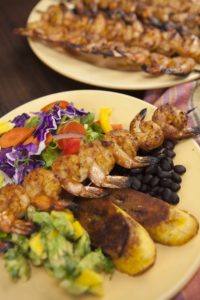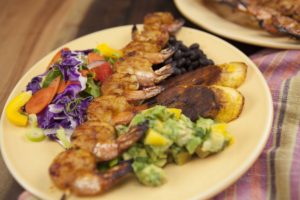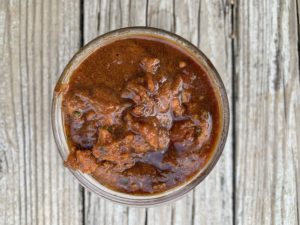 I lived in Michigan working with a volunteer organization for about six months when I was 18 years old. I was the kitchen manager and decided that kabobs would be fun to serve to a group of about 40 people. Yeah, “fun”, I said. Three hours and pans and pans of shish kabobs later, the fun had worn off and no one had been fed. Despite this disastrous executive decision as kitchen manager I still give kabobs another shot about every three years, and I repeatedly come to the same conclusion: kabobs are too time consuming! Chopping all of those vegetables and meat, and then arranging them onto skewers in an order that has balanced flavor and visual appeal is just not how I want to spend my meal prep time. I can think of about ten other cooking methods that could prepare the exact same combination of foods in a fraction of time.
I lived in Michigan working with a volunteer organization for about six months when I was 18 years old. I was the kitchen manager and decided that kabobs would be fun to serve to a group of about 40 people. Yeah, “fun”, I said. Three hours and pans and pans of shish kabobs later, the fun had worn off and no one had been fed. Despite this disastrous executive decision as kitchen manager I still give kabobs another shot about every three years, and I repeatedly come to the same conclusion: kabobs are too time consuming! Chopping all of those vegetables and meat, and then arranging them onto skewers in an order that has balanced flavor and visual appeal is just not how I want to spend my meal prep time. I can think of about ten other cooking methods that could prepare the exact same combination of foods in a fraction of time.
But then it dawned on me that meat kabobs wouldn’t actually take all that much time; it’s the vegetables that are the major time sink. I created an amazing Smoky Thai Barbecue Sauce and started experimenting with different types of kabob meat on the grill. Chicken thighs and beef could be easily cut into one and a half inch-thick strips, threaded onto skewers, smothered in sauce to marinate for a few hours, and then easily grilled to perfection. Now THIS is my type of kabob!
I had the idea that shrimp would work as well, so I picked up a 2lb bag of frozen, peeled and deveined shrimp from Costco and used these as the base for the kabobs. And the winner? Hands down, it was shrimp! Shrimp, especially when purchased peeled and deveined, are an incredibly quick protein to prepare. They’re the perfect size to string upon a kabob and lay flat in a dish while they marinate and they cook extremely fast, so this dish took very little time once all of the other components were ready.
 I served the kabobs with Cuban-spiced black beans (I just made this recipe up as I went, and unfortunately, I don’t have a recipe to share), a simple side salad that was prepped in advance, plantains fried in coconut oil, and the Avocado-Mango Salsa from my cookbook. The whole family loved this meal! The kids even ate the shrimp tails after I repeatedly explained that people don’t usually do that, and that we could instead feed them to the chickens. But, I guess the benefit is that they got a bit more calcium with the meal than I had anticipated.
I served the kabobs with Cuban-spiced black beans (I just made this recipe up as I went, and unfortunately, I don’t have a recipe to share), a simple side salad that was prepped in advance, plantains fried in coconut oil, and the Avocado-Mango Salsa from my cookbook. The whole family loved this meal! The kids even ate the shrimp tails after I repeatedly explained that people don’t usually do that, and that we could instead feed them to the chickens. But, I guess the benefit is that they got a bit more calcium with the meal than I had anticipated.
Make This Meal Easier
One of the repeated themes in my cookbook is that meal planning can be used in an efficient way to simplify meal prep for a busy family. Upon first glance, this meal may appear to be too complicated to serve to a family on a busy weeknight. This is true if you’re preparing every component of the meal from scratch on the day you plan to serve it. But it’s not true if you use your time wisely and plan ahead.

Partially frozen sauce that can be stirred and portioned out as needed from the freezer.
The sauce I used on the shrimp can be easily prepped in bulk and stored in the freezer for a few months. It doesn’t actually freeze (I’m guessing this is due to the high salt content of the soy sauce and coconut aminos), but instead becomes a thick slurry that can be easily stirred and portioned out as needed. I quadrupled the recipe, so that I could prepare chicken, beef, or shrimp (my favorite!) a total of 4 – 8 times depending the the quantity.
I included 4-weeks of meal plans in my cookbook (day-by-day, step-by-step prep instructions will be available as a free download on my website, as well) and every week includes an Everyday Salad. I prep enough salad for an entire week in one sitting, which saves a LOT of time in the long run. The salad you see in this photo is just one example of a salad that can be prepped and stored in the refrigerator for use throughout the week. I then top it with my favorite proteins and fats, and I have a quick and simple side to go with most any meal. (Spoiler alert: I also bulk prep salad dressings!)
The Cuban black beans were also prepped in bulk. I prepared two pounds of dried beans (I would have done three if I had more) by first soaking them for 36 hours and then cooking the beans in the pressure cooker for 30 minutes. I used some for dinner, transferred a portion of leftover beans to the refrigerator for lunch, and froze the remaining four-cups in one-cup portions using Souper Cubes, silicon molds that are amazing for freezing leftovers in an accessible and easily stored fashion. I contacted Michelle, the owner of Souper Cubes, asking for a sample and ended up buying two more of the freezer trays, because they’re so darn useful! I don’t often endorse products (except for high powered blenders and electric pressure cookers), but these trays are absolutely amazing!
When it came time to prepare this meal, I was using a pre-made sauce and an already-prepared salad. Having these two steps complete made it possible to prepare the rest of the dish in about 30 minutes total (the beans were started in advance, but the process was largely hands off), which I consider to be a reasonable amount of time to spend in the kitchen on a busy weeknight. The leftover shrimp, salad, and beans are now being served along with some leftover mashed sweet potatoes from earlier in the week as our lunch for the day.
A Note About Soy and Erythritol
Many people steer clear of soy products for varying reasons. Personally, I don’t feel that soy is particularly offensive unless you’re eating insane quantities or eating a variety that is conventionally grown. Certified organic soy is grown without the use of toxic pesticides, including glyphosate (Round Up), and it’s guaranteed to be sourced from non-GMO seed. There are instances in which people should avoid soy just as there are instances in which people should avoid other offending foods. If this is your experience, simply sub out the gluten-free soy sauce and replace it with coconut aminos. But if you have no issue tolerating soy, I don’t see any reason to avoid using a gluten-free, organic soy sauce as a flavoring in some dishes.
If you follow me frequently, you’ve noticed that I’ve started experimenting with erythritol and monkfruit. Both of these ingredients are naturally occurring sugar alternatives that seem to have well-established safety profiles. I invite you to read my earlier post about erythritol since there are rare instances in which it’s poorly tolerated. These people should clearly omit the erythritol altogether, but I added it to this recipe for just a hint of sweetness. Adding any type of sweetener to a recipe is new thing for me, but I have to say that I’m really enjoying the cooking flexibility that erythritol offers.
I hope you enjoy this recipe. Be sure to share this post with a friend who might want to recreate this same delicious, grain-free dinner idea!
Ingredients
- 1/4 cup gluten free soy sauce
- 1/4 cup coconut aminos
- 1/4 cup sesame oil
- 2 tablespoons tomato paste
- 1 tablespoon red or green curry paste (I use Thai Kitchen brand)
- 2 tablespoons dried chives
- 1 teaspoon garlic powder
- 1/2 teaspoon smoked paprika
- 1 tablespoon erythritol
- 2 lbs peeled and deveined 31-40 count shrimp
- 1 cup Smoky Thai Barbecue Sauce
- 8 - 10 skewers
Instructions
- Blend the soy sauce, sesame oil, coconut aminos, tomato paste, and curry paste in a blender for abut 5 seconds or in a jar using an immersion blender until smooth. If you don't have a blender, start by mashing the tomato paste and curry paste into the oil using a fork or the back of a spoon until completely smooth. The pastes won't easily mix into the sauce by stirring or shaking alone.
- Pour the mixture into a pint-sized glass jar with a lid, add all remaining ingredients, and shake vigorously until everything is combined, 20-30 seconds.
- Use the sauce immediately, or store it in the refrigerator for up to 10-days or in the freezer for up to 3 months.
- Place 9 - 10 shrimp on each skewer and pile the kabobs into a shallow food storage container or onto a large plate.
- Pour the sauce over the kabobs being sure to evenly coat all sides of the shrimp. Allow the shrimp to marinate in the refrigerator for a minimum of 30 minutes, but 2 hours is best. Do not marinate meat for more than 24 hours or the fibers start to degrade.
- Preheat the grill to high heat and grill each side of the kabobs for about 5 minutes or until the shrimp are cooked through. Cooking time varies depending on your grill temperature.
- Serve kabobs immediately or store leftovers in the refrigerator for up to three days.
Notes
The sauce can be used on a variety of meats included chicken thighs and steak. I recommend doubling or even quadrupling the recipe and storing leftovers in the freezer (see "Make This Meal Easier" in blog post for more information). See "A Note About Soy and Erythritol" for substitution ideas.
Leave a Reply